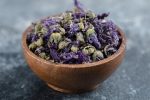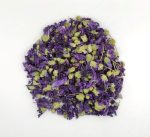MRT food
MRT Food is an organic products company in Iran that operates under the supervision of the European Organic Union and international standards.
This company sends organic products such as sour tea, saffron, Common Mallow ,blue mallow ,Damask rose ,Thyme ,Organic Hibiscus tea bags to all countries of the world.
These products are made under the supervision of experts and with organic methods
And it is exported by air and sea with modern methods.
Order stages
- Fill the query form
- Wait for us to send you the specification and invoice
- Pay a deposit based on the invoice
- Choose one of the stages of export
- Wait until the product are loaded and shipped
Health Benefits of common mallow
Traditionally, these medicinal plants have been used to treat several infections and diseases, such as cold, burn, cough, tonsillitis, bronchitis, digestive problems, eczema, and cut wounds under different weather conditions. As a natural product, mallow leaves and mallow flowers showed various therapeutic effects.
In herbal medicine, mallow is classified as a demulcent—a soothing agent that counters irritation and mild inflammation. Both mallow leaf and flower preparations are approved by the German Commission E for relief of sore throats and dry coughs. Mallow is typically used as a tea or gargle for these indications.
Also its Effective in the following situation:
- Bronchitis
- Stomach upset.
- Bladder problems.
- Diarrhoea.
- Irritation of the mouth and throat.
- Dry cough.
- Wounds, when applied to the skin or added to the bath.
- Other conditions.
In addition, this organic mallow contains many valuable compounds such as strong antioxidants, carbohydrates and unsaturated fatty acids. The tannins, flavonoids, phenolic compounds, and ascorbic acid found in the Mallow plant are used to treat most cancers and for wound healing.
- Antioxidant activity
Organic mallow contains antioxidants that can help combat free radicals in the body, protecting cells from oxidative stress and damage. These antioxidants may have potential anti-aging effects and contribute to overall health and well-being.
- Antimicrobial activity
Organic Mallow has antimicrobial activity against various bacterial and fungal species. The disc diffusion method reported the antimicrobial activity of blue mallow extracts against several bacterial species. The researchers found that common mallow had moderate activity against selected microorganisms associated with typical antibiotics.
- Anticancer activity
Coumarins from Mallow have a potential anticancer activity. Blue mallow also contains essential as well as non-essential elements and minerals.
- Hepatoprotective activity
The literature has confirmed the presence of antioxidant compounds in common mallows. These compounds, in turn, remove free radicals and help protect tissues, especially in the liver.
- Wound healing activity
Topical application of the hydroalcoholic ethanolic extract of organic mallow leaves dose-dependently increases the rate of contraction of skin ulcers and reduces the duration of the repair process in skin.
- Antinociceptive activity
The antinociceptive activity of aqueous extracts of blue mallow was evaluated in a study against traditional pain models in mice.
- Anti Inflammatory activity
Common Mallow contains compounds with anti-inflammatory effects, which may help reduce inflammation in the body. It has traditionally been used to alleviate symptoms of respiratory conditions, such as coughs, bronchitis, and sore throat.
Here is a table of nutritional facts about Common Mallow ( Malva ) :
| Nutrient | Amount per 100g |
|---|---|
| Calories | 31 |
| Protein | 2.0g |
| Fat | 0.8g |
| Carbohydrates | 6.6g |
| Fiber | 1.5g |
| Calcium | 47mg |
| Iron | 1.9mg |
| Magnesium | 34mg |
| Phosphorus | 38mg |
| Potassium | 197mg |
| Vitamin C | 36mg |
| Vitamin A | 1027 IU |
| Vitamin K | 177 µg |
Recipes of common mallow
Traditionally, mallow has been used by adults as a tea prepared by steeping dried flowers or dried leaves.
Iranians use mallow alot in their foods and drinks . thy use it in the following days:
- use the petals of this plant to color confectionery products.
- Its leaves can be consumed raw.
- make tea and herbs from its stems and flowers.
- Use the petals and buds of this flower in salads.
- Its young stems are edible.
- use it in all kinds of stews and soups as a vegetable
But there are a lot of other ways to make a mallow tea:
This way is SO simple, all you have to do is:
- Place 1/4 cup dried mallow flowers in a quart-size Mason jar or pitcher.
- Pour in 4 cups of filtered water and stir.
- Chill in the refrigerator until the tea is bright red, at least 20 minutes. Let it chill overnight for a deeper colour and flavor.
- Strain the mixture into a pitcher to remove the hibiscus petals.
Iranians always drink hot tea even in the middle of the summer, but you can Serve this tea in glasses filled with ice. If you like, stir in a sweetener such as honey, agave, or maple syrup to taste. Garnish with fresh mint leaves and raspberries, and enjoy!
References
Update history

![20230728145056_[fpdl.in]_dried-purple-flowers-wooden-bowl_114579-84691_full Common Mallow](https://mrtfoods.com/wp-content/uploads/2023/07/20230728145056_fpdl.in_dried-purple-flowers-wooden-bowl_114579-84691_full.jpg)



